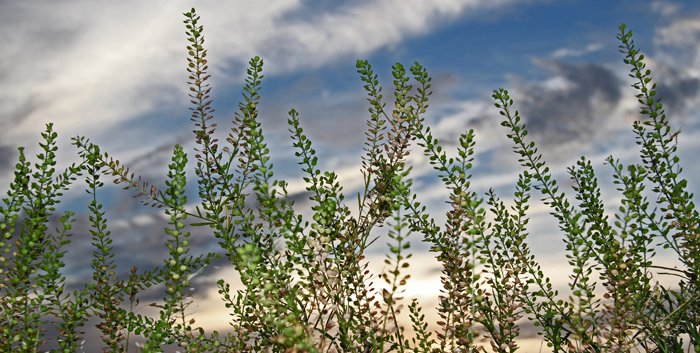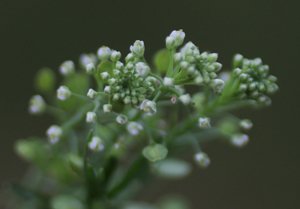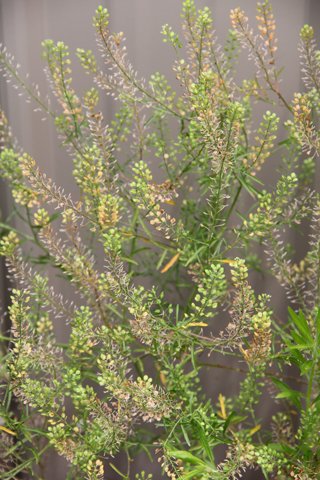





Sometimes common roadside weeds have an interesting history.
 Lepidium virginicum, Virginia peppergrass, is also known as 'poor man's pepper' and is a North American Native that tends to grow along roadsides and in waste areas. It is a member of the huge Brassicacae family which includes familiar plants like mustard and broccoli. The distinctive little seed pods and bottle brush appearance, makes it easily recognizable and there aren't any poisonous look-alikes. It was used as a food seasoning in a time when little else was available.
Lepidium virginicum, Virginia peppergrass, is also known as 'poor man's pepper' and is a North American Native that tends to grow along roadsides and in waste areas. It is a member of the huge Brassicacae family which includes familiar plants like mustard and broccoli. The distinctive little seed pods and bottle brush appearance, makes it easily recognizable and there aren't any poisonous look-alikes. It was used as a food seasoning in a time when little else was available.
This plant has a long medicinal history with Native Americans. They used the crushed leaves as a poultice for insect bites and poison ivy. It also has a significant amount of Vitamin C and was used to treat scurvy. The seeds have anti-asthmatic properties and were used to treat coughs and croups and the crushed roots were used to draw wounds and blisters. Modern medicine is exploring its anti-microbal properties as a possible treatment for dysentery and similar conditions. The young leaves were used as a potherb in the spring and often flavored many pioneer dishes. They have a pleasant, mustardy 'bite' when eaten and the ground seeds were often used a s a substitute for black pepper and often seasoned meats and soups. In today's world, hikers like to nibble the seeds or leaves as they walk along the trails and the chewed 'poultice' can be applied to mosquito bites and other ailments.
The young leaves were used as a potherb in the spring and often flavored many pioneer dishes. They have a pleasant, mustardy 'bite' when eaten and the ground seeds were often used a s a substitute for black pepper and often seasoned meats and soups. In today's world, hikers like to nibble the seeds or leaves as they walk along the trails and the chewed 'poultice' can be applied to mosquito bites and other ailments.
Lepidium virginicum has spread and naturalized around the world and can be found on all continents. The seeds are easily distributed, because once the foliage has died back, it will often break off at ground level and roll about much like a tumbleweed. Plants are often found in abandoned lots and parking areas as it tends to thrive in waste areas. It isn't much of a pest to farmers, however, dairy farmers consider it an unwelcome plant since it can alter the taste of the milk their cows produce if they consume it. Virginia peppergrass is a host plant for a number of butterflies. The Cabbage Whites, Checkered Whites and Sulphurs among them. Gardeners do not realize that by eliminating wild plants form their gardens, they are eliminating the food source for the caterpillars that ultimately become butterflies. Without these specific host plants, the butterflies cannot reproduce and so there are fewer butterflies for the garden. Please remember to do them the kindness of leaving a few plants available in some out of the way corner of the garden for them to lay their eggs. It is a small thing we can do to help future generations of 'flying flowers' find a home for their young.
Virginia peppergrass is a host plant for a number of butterflies. The Cabbage Whites, Checkered Whites and Sulphurs among them. Gardeners do not realize that by eliminating wild plants form their gardens, they are eliminating the food source for the caterpillars that ultimately become butterflies. Without these specific host plants, the butterflies cannot reproduce and so there are fewer butterflies for the garden. Please remember to do them the kindness of leaving a few plants available in some out of the way corner of the garden for them to lay their eggs. It is a small thing we can do to help future generations of 'flying flowers' find a home for their young.
It is amazing how many plants actually do have documented helpful properties when the scientific world examines them. There was a pharmacy growing in the fields and along the rivers where our ancestors lived, hunted and gathered food. Of course, you should only use plants that have been positively identified and seek a professional medical opinion for anything more serious than a bug bite. Modern medicine has come a long way since then and there are better and safer treatments available, but it is excellent knowledge to have available in case of an emergency.
Copyright © www.100flowers.win Botanic Garden All Rights Reserved